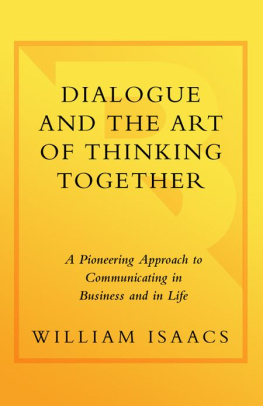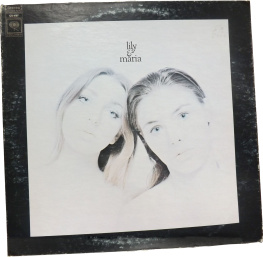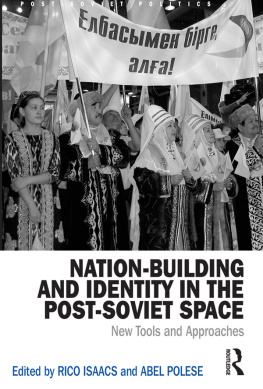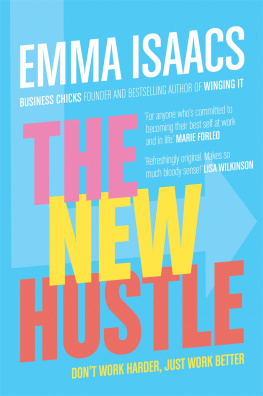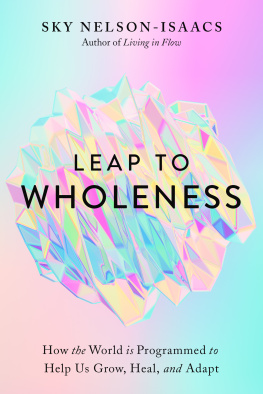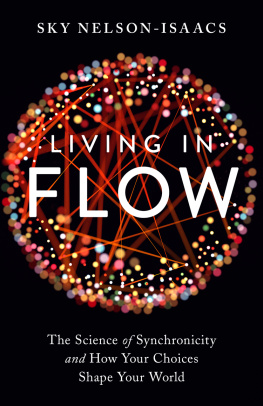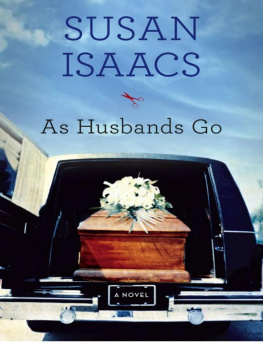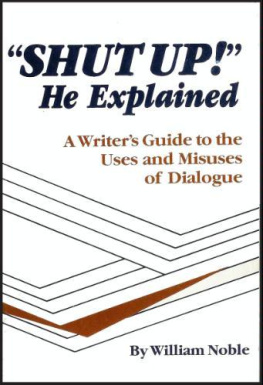William Isaacs - Dialogue and the art of thinking together
Here you can read online William Isaacs - Dialogue and the art of thinking together full text of the book (entire story) in english for free. Download pdf and epub, get meaning, cover and reviews about this ebook. year: 2008, publisher: Random House, Inc., genre: Politics. Description of the work, (preface) as well as reviews are available. Best literature library LitArk.com created for fans of good reading and offers a wide selection of genres:
Romance novel
Science fiction
Adventure
Detective
Science
History
Home and family
Prose
Art
Politics
Computer
Non-fiction
Religion
Business
Children
Humor
Choose a favorite category and find really read worthwhile books. Enjoy immersion in the world of imagination, feel the emotions of the characters or learn something new for yourself, make an fascinating discovery.
- Book:Dialogue and the art of thinking together
- Author:
- Publisher:Random House, Inc.
- Genre:
- Year:2008
- Rating:4 / 5
- Favourites:Add to favourites
- Your mark:
- 80
- 1
- 2
- 3
- 4
- 5
Dialogue and the art of thinking together: summary, description and annotation
We offer to read an annotation, description, summary or preface (depends on what the author of the book "Dialogue and the art of thinking together" wrote himself). If you haven't found the necessary information about the book — write in the comments, we will try to find it.
Dialogue and the art of thinking together — read online for free the complete book (whole text) full work
Below is the text of the book, divided by pages. System saving the place of the last page read, allows you to conveniently read the book "Dialogue and the art of thinking together" online for free, without having to search again every time where you left off. Put a bookmark, and you can go to the page where you finished reading at any time.
Font size:
Interval:
Bookmark:


PART I:
PART II:
PART III:
PART IV:
PART V:
For
Jody
and
Sam
No serious book simply arrives fully born. It is forged, some would say squeezed, out of the very marrow of one's psyche. This book has been no exception. I have been blessed to have had the assistance of many people over the years in this process, and in fact would have been unable to succeed without them. Acknowledging them is both a great pleasure and something of a risk, since one is inevitably unaware of all the contributions that have actually shaped one's life and work.
The most important statement I think I could make here is to acknowledge that there is a growing community of people around the world who have both a commitment to and real capacity for living the ideas represented in this book. Their contributions where they are will in the end be far more significant than any words in any book. As we cross the threshold to a new millennium, I am encouraged to know of many who are endeavoring both to reshape the institutions of the industrial age, and to bring new music into the world, and who have an increasingly conscious perspective on the changes required of all of us.
First, David Bohm's ideas, and perhaps even more important, his extraordinary and often breathtaking capacity for genuine inquiry, have shaped all aspects of this book. Sarah Bohm unwaveringly fostered the spirit of dialogue for me and many others. Martin Exeter set a standard of spiritual character that made undeniably visible the wholeness many only speak about. David Kantor has been a colleague, mentor, and friend for a decade. He has contributed in numerous ways to my thinking process and theory development. In my work I have tried to incorporate something of what remains most impressive in this man: his extraordinary capacity as an interventionist to help human beings to untie their own knots and liberate themselves. His compassionate ability on this score remains unparalleled, and is I believe an essential feature for enabling genuine dialogue.
Chris Argyris and Donald Schn taught me a great deal about the pervasive and self-defeating habits of action in human beings. Their work on conversation remains the gold standard of rigor in this domain. Peter Senge has been a friend and colleague for many years now too. He is a remarkable learner, and has a powerful ability to generate insights and communicate them in a way that allows many others to prosper. I want to thank him for his Foreword, and for his steady support and encouragement of both my work and this field. Ed Schein has also been a close friend and ally for many years now. Ed's comments and reading of the manuscript were of great value. In many ways my work stands on the shoulders of such giants as him, one whose clarity of thought and insight about what is valuable for human beings gave dialogue a needed boost at a critical moment.
Several colleagues have provided enormous help in the development of many of the ideas here. Peter Garrett has been a friend and colleague for some twenty years now. His partnership and originality of thought greatly helped David Bohm, and greatly helped me. He has made a significant contribution to the formulation of the principles of dialogue. And his inspired hand and lucid mind can be felt in virtually every other idea here.
Michael Jones brought a fierce and gende determination to keep the awareness of beauty before us all. Mitch Saunders' friendship and creative wisdom provided an enormously potent field within which this work could form. Barbara Coflman facilitated some of the first dialogue sessions we held in the United States, and provides exemplary leadership in this field. Otto Scharmer has developed a fine theory of communication and field development that dovetails with my own work and greatly enriched it.
Diana Smith has been a steady inspiration to me, encouraging me to be true to my own voice. David Skaggs contributed much perspective for the section on dialogue and democracy. Mark Gerzon's reading of the manuscript pointed me in the right direction and greatly assisted in helping this book come to clarity. Jessica Lipnack and Jeffrey Stamps offered helpful and genuine encouragement. Bruce Allyn offered helpful advice and assistance in the section on the Hague Initiative, as well as being a friend and support for the overall journey. Chris Thorsen and Richard Moon have pioneered in the realm of physical analogues for dialogue, bringing aikido and dialogue together. They offered many helpful insights. Glennifer Gillespie and Beth Jandernoa have nurtured both me and this book. Danah Zohar inspired me to keep going, and provided genuine intellectual companionship. Diana and Jon Guilbert's dear friendship, vision, and straightforward feedback are a lifeline and source of real strength. Daniel Kim of Pegasus Communications has been a colleague and voice of encouragement for some years too, always encouraging me to take the next risk.
Cliff Barry and Mary Ellen Blandford have been immensely helpful to me over the years as both friends and advisors. Their thinking about intrapersonal structures and their skill in releasing the inner circuitry that keeps people stuck are both stunning and extraordinary; they have transformed my life and energized the thinking in this book.
Many people participated in The Dialogue Project at MIT, where this book got its start. I want to thank all of those who played their parts in this. Larraine Matusak championed the work at the Kellogg Foundation. Many people have been blessed by her vision, and I feel especially fortunate on this score. The Organizational Learning Center at MIT provided a safe haven for the project. Many people within the Center actively helped with the project, especially Jeff Clanon, Vicki Tweiten, Jean MacDonald, Angela Lipinski, Jane Punchard, and George Roth. Their support and interest continue within the Society for Organizational Learning. Mary Fewel Tulin and Uli Dettling played important roles in shaping the dialogue research. Mary Ellen Hynes, Michelle Martin, and Nina Kruschwitz all ably administered the project and acted as the glue that held it all together.
The Dialogue Facilitator Group was the seedbed for many of these ideas. These people are exemplars of this work in the world, and include: Juanita Brown, Sarita Chawla, Barbara Coffman, Freeman Dhority, John Gray, Robert Hanig, Sue Miller Hurst, Ron and Susan Kertzner, Nomatemba Luhabe, Harold Massey, Ken Murphy, Marilyn Paul, Agota Rusza, and Mitch Saunders.
The team at DIAlogos has had enormous patience and been deeply committed to sustaining our business and keeping the spirit of it alive, even though I was often absent from it. Sabra Dalby's large heart and meticulous spirit nurtured and sustained us all. Joan Wickizer ran our office in ways that I still marvel at. B. C. Huselton was one of the early pioneers in the dialogue work while he was with Armco. He has been a constant and dear friend for many years, a determined strategist and an able representative of this work. I also want to thank Janet Gould, Carmen Barmakian, Eric DeLuca, Kate Pugh, Tiffany Roach, and Kristin Collins for their generosity and commitment.
The graduates of DIA logos's educational and leadership development programs have been enormously influential. They provided the living laboratory from which many others will benefit. Pam Paquin and Wendy MacPhedran both provided fine logistical support and authentic encompassment of the people who came through our doors.
Font size:
Interval:
Bookmark:
Similar books «Dialogue and the art of thinking together»
Look at similar books to Dialogue and the art of thinking together. We have selected literature similar in name and meaning in the hope of providing readers with more options to find new, interesting, not yet read works.
Discussion, reviews of the book Dialogue and the art of thinking together and just readers' own opinions. Leave your comments, write what you think about the work, its meaning or the main characters. Specify what exactly you liked and what you didn't like, and why you think so.

